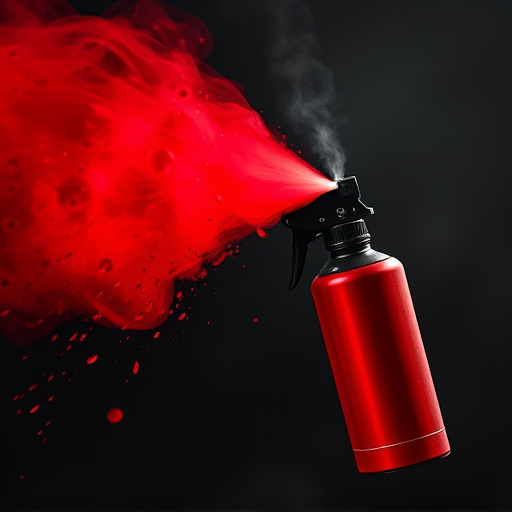Non-lethal pepper spray defense, or oleoresin capsicum (OC) spray, is a strategic tool for law enforcement to manage crowd dynamics without causing permanent harm. It temporarily incapacitates individuals through eye, nose, and respiratory irritation, enabling officers to gain control and preserve public safety during protests, civil unrest, or high-risk operations. Proper training ensures responsible use and minimizes risks, making it a preferred choice over lethal force for effective crowd control.
In recent years, law enforcement agencies have increasingly turned to non-lethal pepper spray as a crowd control measure. This strategic shift has sparked debates about its effectiveness and safety in various scenarios. This article delves into the world of non-lethal pepper spray defense, exploring its role, mechanisms, deployment protocols, and potential alternatives. By understanding these aspects, we can navigate crowd management more effectively while ensuring public safety.
- Understanding Non-Lethal Pepper Spray for Crowd Control
- The Role of Pepper Spray in Law Enforcement Tactics
- How Pepper Spray Works and Its Effects on Crowds
- Safety Measures and Training for Pepper Spray Deployment
- Exploring Alternatives to Pepper Spray for Crowd Management
Understanding Non-Lethal Pepper Spray for Crowd Control
Pepper spray, often referred to as oleoresin capsicum (OC) spray, is a non-lethal crowd control measure used by law enforcement agencies worldwide. This chemical agent temporarily incapacitates individuals, providing officers with time to gain control of volatile situations and ensure public safety. It works by causing a burning sensation in the eyes, runny nose, coughing, and difficulty breathing, allowing subjects to be restrained or arrested without causing permanent harm.
Non-lethal pepper spray defense is a strategic tool for police to de-escalate potentially dangerous crowds or individuals. When deployed responsibly, it disrupts crowd dynamics, giving law enforcement the upper hand in managing public order. Understanding its effective range, activation mechanisms, and safety protocols is crucial for both officers and bystanders, ensuring that this powerful tool serves its intended purpose of crowd control without causing severe injuries.
The Role of Pepper Spray in Law Enforcement Tactics
Pepper spray, a non-lethal weapon, has become an integral part of modern law enforcement tactics. It serves as a crucial tool for officers to control and disperse crowds during various situations, including protests, civil unrest, or high-risk operations. This chemical agent temporarily incapacitates individuals by irritating the eyes, nose, and respiratory system, allowing police to gain control and ensure public safety.
In crowd control scenarios, pepper spray offers several advantages. It is an effective deterrent, enabling officers to manage large assemblies while minimizing physical harm. The non-lethal nature of pepper spray makes it a preferred choice over lethal force, promoting a more measured response from law enforcement. With proper training and handling, officers can utilize this tool to de-escalate tensions and maintain order efficiently.
How Pepper Spray Works and Its Effects on Crowds
Pepper spray, also known as oleoresin capsicum (OC) spray, is a non-lethal defense mechanism used by law enforcement to control and disperse crowds. It works by targeting the body’s nervous system, specifically the eyes, nose, and respiratory tract. When pepper spray comes into contact with these areas, it triggers a response that leads to temporary disability, making it an effective crowd control tool. The primary effects include tearing, burning sensation, coughing, difficulty breathing, and pain in the affected areas, all of which help to break up large gatherings quickly and safely.
Unlike lethal force, pepper spray is designed to incapacitate individuals temporarily without causing permanent harm or death. This non-lethal aspect makes it a preferred choice for law enforcement agencies, especially in situations where crowd control is necessary to prevent violence or property damage. By using pepper spray strategically, police can effectively manage public gatherings while minimizing the risk of injuries or fatalities, ensuring the safety of both officers and citizens.
Safety Measures and Training for Pepper Spray Deployment
In the realm of crowd control, law enforcement agencies increasingly rely on non-lethal pepper spray as a defense mechanism, prioritizing safety for both officers and citizens. This strategic decision involves rigorous training protocols to ensure effective and responsible deployment. Officers are taught to assess situations accurately, considering factors like crowd dynamics, potential threats, and proximity to bystanders. Proper training equips them with the skills to deploy pepper spray precisely, minimizing harm while maximizing its disruptive effect on unruly crowds.
The use of non-lethal pepper spray demands a nuanced approach, balancing the need for control with public safety. Training sessions focus on techniques that allow officers to manage large gatherings, disrupt violent or aggressive behavior, and facilitate the peaceful resolution of conflicts. By mastering these skills, law enforcement can maintain order while adhering to their primary goal: protecting the well-being of all involved in potentially volatile situations.
Exploring Alternatives to Pepper Spray for Crowd Management
In recent years, there has been a growing interest in exploring alternatives to pepper spray for crowd control due to concerns about its potential harm and the emergence of non-lethal weapons as more humane options. Non-lethal pepper spray defense offers a middle ground between traditional law enforcement tactics and complete de-escalation strategies. While effective in dispersing crowds, it reduces the risk of severe injury or long-term health issues associated with some other crowd control measures.
Research has focused on developing safer alternatives, such as foam rubber bullets, Tasers, and water cannons. These tools aim to incapacitate individuals without causing permanent damage. Additionally, de-escalation techniques, including verbal communication, crowd management training for officers, and the use of physical barriers, have gained prominence. These methods prioritize peaceful resolution, minimizing the need for chemical agents or other potentially harmful interventions.
Non-lethal pepper spray has emerged as a valuable tool in law enforcement, offering an effective crowd control measure while prioritizing safety. By understanding its mechanisms and proper deployment, officers can navigate challenging situations with greater control. As we explore alternatives, it’s evident that non-lethal pepper spray defense remains a crucial component of modern policing strategies, striking a balance between public safety and peaceful resolution.
